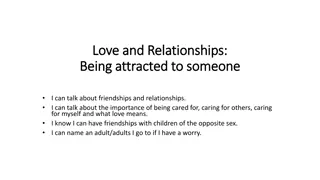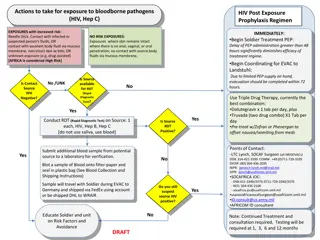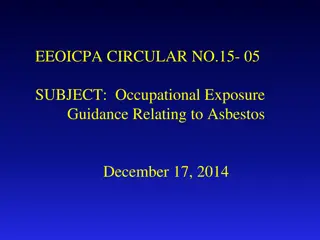Understanding Attraction and the Mere Exposure Effect
Explore the dynamics of attraction and romantic love, delving into why we are drawn to certain individuals and how familiarity influences our feelings. Uncover key factors such as proximity, attractiveness, and similarity, along with the intriguing concept of the mere exposure effect, which elucidates how repeated exposure to stimuli can enhance liking. Discover how familiarity can lead to acceptance, even illustrated by the heartwarming tale of a unique penguin finding its place among its peers. Moreover, consider how the mere exposure effect extends to our perception of ourselves, showcasing the interconnectedness of human relationships and self-perception.
Download Presentation

Please find below an Image/Link to download the presentation.
The content on the website is provided AS IS for your information and personal use only. It may not be sold, licensed, or shared on other websites without obtaining consent from the author. Download presentation by click this link. If you encounter any issues during the download, it is possible that the publisher has removed the file from their server.
E N D
Presentation Transcript
Learning Targets 79-1 Explain why we befriend or fall in love with some people but not others. Module 79 79-2 Describe how romantic love typically changes as time passes. Attraction
What makes us attracted to some people and not to others? Talk about it. Does familiarity breed contempt, or does it amplify affection? Do birds of a feather flock together, or do opposites attract? Is it what s inside that counts, or does physical attractiveness matter too?
What are three factors in attraction? proximity attractiveness similarity
What is the mere exposure effect? the phenomenon that repeated exposure to novel stimuli increases liking of them For our ancestors, this mere exposure effect likely had survival value. What was familiar was generally safe and approachable. What was unfamiliar was more often dangerous and threatening. Evolution may therefore have hard-wired into us the tendency to bond with those who are familiar and to be wary of those whose looks are unfamiliar. (Sofer et al., 2015; Zajonc, 1998)
How does familiarity lead to acceptance? When this rare white penguin was born in the Sydney, Australia zoo, his tuxedoed peers ostracized him. Zookeepers thought they would need to dye him black to gain acceptance. But after three weeks of contact (mere exposure), the other penguins came to accept him.
Does the mere exposure effect apply to our self? Researcher Lisa DeBruine found that humans like other people when their faces incorporate some morphed features of their own. When McMaster University students played a game with a supposed other player, they were more trusting and cooperative when the other person s image had some of their own facial features morphed into it.
1. What Would You Answer? Which of the following is an example of the mere exposure effect? A. Adrianna has started arriving tardy to her second period class to avoid a group of kids in the hall who tease her. B. Abe has biked the same route to school so many times that he no longer has to think about where to turn. C. Daiyu has seen the same toothpaste ad on television a hundred times. Each time she sees it she hates it more. D. Abdul has always loved dogs, so he adopted one from the local shelter. E. Guiren didn t like sushi the first couple of times he tried it, but his friend encouraged him to keep eating it and now it s one of his favorite foods.
Which us is the real us? Because the human face is not perfectly symmetrical, the face we see in the mirror is not the same face our friends see. Most of us prefer the familiar mirror image, while our friends like the reverse. (Mita et al., 1977)
How has online dating increased in the last decade? Percentage of heterosexual and same-sex couples who met online. (Data from Rosenfeld & Thomas, 2012.)
What research has been conducted on the importance of attractiveness? In one study, researchers randomly matched new University of Minnesota students for a Welcome Week dance. Before the dance, the researchers gave each student a battery of personality and aptitude tests, and they rated each student s physical attractiveness. During the blind date, the couples danced and talked for more than two hours and then took a brief intermission to rate their dates.
What were the results? What predicted whether they liked each other? Only one thing: appearance. Both the men and the women liked good-looking dates best. (Walster et al., 1966)
Thinking critically. The Walster et al. study was conducted in 1966. How relevant do you feel their results are today? Is appearance still the overriding characteristic that determines attractiveness? Talk with your class.
What is considered attractive? Conceptions of attractiveness vary by culture and over time. Yet some adult physical features, such as a healthy appearance and a relatively symmetrical face, seem attractive everywhere.
What is attractive? Which of these faces offered by University of St. Andrews psychologist David Perrett is most attractive? Most people say it s the face on the right of a nonexistent person that is the average composite of these 3 plus 57 other actual faces.
What makes a face attractive? Facial features that are neither unusually large nor small and symmetrical faces and bodies are perceived as more sexually attractive (Rhodes et al., 1999; Singh, 1995; Thornhill & Gangestad, 1994)
How do our feelings influence our perceptions of attractiveness? Given two people, one that is honest, humorous, and polite and the other that is rude, unfair, and abusive, most people perceive the person with the appealing traits as more physically attractive. (Lewandowski et al., 2007) As we see our loved ones again and again, their physical imperfections grow less noticeable and their attractiveness grows more apparent. (Beaman & Klentz, 1983; Gross & Crofton, 1977)
So, do opposites really attract? Compared with randomly paired people, friends and couples are far more likely to share common attitudes, beliefs, and interests (and, for that matter, age, religion, race, education, intelligence, smoking behavior, and economic status). Moreover, the more alike people are, the more their liking endures. (Byrne, 1971; Hartl et al., 2015) In real life, opposites retract. (Rosenbaum 1986; Montoya & Horton, 2013)
similarity Similarity attracts; perceived dissimilarity does not.
How does being liked and respected ourselves impact attractiveness of others? When we believe someone likes us, we feel good and respond to them warmly, which leads them to like us even more. (Curtis & Miller, 1986) We will like those whose behavior is rewarding to us, including those who are both able and willing to help us achieve our goals. (Montoya & Horton, 2014)
Think about it and apply your understanding. Think of your closest friends. What factors led to your getting to know them, and to liking them more and more? How does the mere exposure effect, similarity and proximity help explain your friendships? Talk about it with a partner.
How does love change over time? Sometimes people move quickly from initial impressions, to friendship, to the more intense, complex, and mysterious state of romantic love. If love endures, temporary passionate love will mellow into a lingering companionate love. (Hatfield, 1988)
What is passionate love? an aroused state of intense positive absorption in another, usually present at the beginning of a romantic relationship Passionate love mixes something new with something positive. (Aron et al., 2000; Coulter & Malouff, 2013). We intensely desire to be with our partner. (Hatfield et al., 2015)
passion Seeing our partner stimulates blood flow to a brain region linked to craving and obsession. (Acevedo et al., 2012)
What is the Schachter-Singer Two-Factor theory of emotion? Our physical reactions and our thoughts (perceptions, memories, and interpretations) together create emotion. In Schachter and Singer s two-factor theory, emotions have two ingredients: physical arousal and cognitive appraisal. An emotional experience, they argued, requires a conscious interpretation of arousal.
What research has been conducted on the Schachter two-factor theory and attraction? In one experiment, researchers studied people crossing two bridges above British Columbia s rocky Capilano River. One, a swaying footbridge, was 230 feet above the rocks; the other was low and solid. As men came off each bridge, an attractive young female researcher intercepted them and asked them to fill out a short questionnaire. She then offered her phone number in case they wanted to hear more about her project.
What were the results of this research? Far more of the men who had just crossed the high bridge which left their hearts pounding accepted the number and later called the woman. The physical arousal (heart pounding) + the cognitive appraisal ( I must find her attractive ) = attractiveness. To be revved up and to associate some of that arousal with a desirable person is to feel the pull of passion.
What is companionate love? the deep affectionate attachment we feel for those with whom our lives are intertwined As love matures, it typically becomes a steadier companionate love, a deep, affectionate attachment. (Hatfield, 1988) In the most satisfying marriages, attraction and sexual desire endure, minus the obsession of early stage romance. (Acevedo & Aron, 2009)
2. What Would You Answer? Over time, A. passionate and companionate love both decrease. B. passionate love increases and companionate love decreases. C. passionate and companionate love both increase. D. passionate love decreases and companionate love increases. E. there is no consistent relationship between the levels of passionate love and companionate love.
applying your knowledge Think of some of the older couples you know. Which ones seem to experience companionate love? How do you think they ve achieved it? Share your thoughts with a partner.
What chemicals are involved in love? During the passionate love phase, passion- facilitating hormones and neurotransmitters such testosterone, dopamine, and adrenaline, flood the body and produce intense physiological changes. As passionate love transitions to companionate love, the release of oxytocin supports feelings of trust, calmness, and bonding with the mate.
What is equity? a condition in which people receive from a relationship in proportion to what they give to it When equity exists, the chances for sustained and satisfying companionate love have been good. (Gray-Little & Burks, 1983; Van Yperen & Buunk, 1990). In one national survey, sharing household chores ranked third, after faithfulness and a happy sexual relationship, on a list of nine things people associated with successful marriages.
What is self-disclosure? the act of revealing intimate aspects of ourselves to others Sharing includes self-disclosure, revealing likes and dislikes, dreams and worries, and both proud and shameful moments. Self-disclosure breeds liking, and liking breeds self-disclosure. (Collins & Miller, 1994)
enduring love This 5000 to 6000- year-old Romeo and Juliet young couple was unearthed locked in embrace, near Rome.
How important is positive support? Relationship conflicts are inevitable, but hurtful communications are not. For unhappy couples, disagreements, criticisms, and put downs are routine. For happy couples in enduring relationships, positive interactions (compliments, touches, laughing) outnumber negative interactions (sarcasm, disapproval, insults) by at least 5 to 1. (Gottman, 2007; see also Sullivan et al., 2010)
Learning Target 79-1 Review Explain why we befriend or fall in love with some people but not others. Proximity (geographical nearness) increases liking, in part because of the mere exposure effect exposure to novel stimuli increases liking of those stimuli. Physical attractiveness increases social opportunities and improves the way we are perceived. Similarity of attitudes and interests greatly increases liking, especially as relationships develop. We also like those who like us.
Learning Target 79-2 Review Describe how romantic love typically changes as time passes. Intimate love relationships start with passionate love an intensely aroused state. Over time, the strong affection of companionate love may develop, especially if enhanced by an equitable relationship, by intimate self-disclosure, and positive support.























